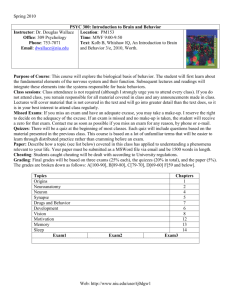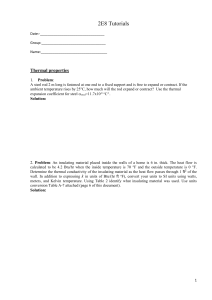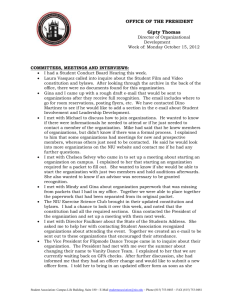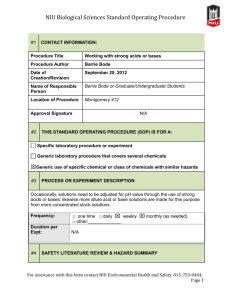Transient Hot-Wire Thermal Conductivity Apparatus Cell
advertisement
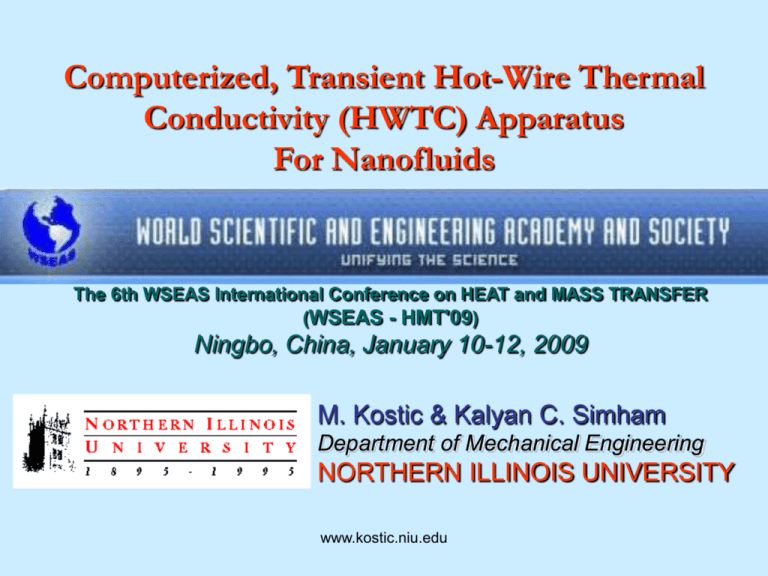
Computerized, Transient Hot-Wire Thermal Conductivity (HWTC) Apparatus For Nanofluids The 6th WSEAS International Conference on HEAT and MASS TRANSFER (WSEAS - HMT'09) Ningbo, China, January 10-12, 2009 M. Kostic & Kalyan C. Simham Department of Mechanical Engineering NORTHERN ILLINOIS UNIVERSITY www.kostic.niu.edu Overview INTRODUCTION OBJECTIVE THEORY OF HOT-WIRE METHOD PRACTICAL APPLICATION OF HOT-WIRE METHOD DESIGN OF HOT-WIRE CELL INSTRUMENTATION DATA ACQUISTION CALIBRATION UNCERTAINTY ANALYSIS RESULTS CONCULSIONS RECOMMENDATIONS www.kostic.niu.edu INTRODUCTION Nanofluids are colloidal suspensions of nanoparticles, nanofibers, nanocomposites in common fluids They are found to have enhanced thermal properties, especially thermal conductivity Thermal conductivity values of nanofluids may be substantially higher than related prediction by classical theories No-well established data or prediction formula suitable to all nanofluids Experimental thermal conductivity measurement of nanofluids is critical www.kostic.niu.edu Table 1: Summary of landmark development in nanofluids * www.kostic.niu.edu * (reprinted with permission; reference listed within this table are with respect to (Manna et al 2005)) Nanofluid Preparation Methods • One Step (Direct Evaporation and Condensation) Method • Two Step Method or Koolaid Method • Chemical Method Fig1: Improved new-design for the one-step, direct evaporation-condensation nanofluid production apparatus, (Kostic 2006) www.kostic.niu.edu Thermal Conductivity • Material Property • Determines ability to conduct heat • Important for thermal Management Classification of Thermal Conductivity Measurement Techniques for Fluids Horizontal Flat Plate Method Steady State Methods Vertical Coaxial Cylinder Method Steady State Hot-Wire Method Line Source (Hot-Wire) Method Non-Steady State Methods Cylindrical Source Method Spherical Source Method www.kostic.niu.edu Plane Source Method Transient Hot-Wire Method for Fluids Advantages: • Fast and Accurate • Minimum Conduction and Radiation losses • Minimize (or even avoid) Convection Classification of Hot-Wire Methods • Standard Cross Wire Method • Single Wire, Resistance Method • Potential Lead Wire Method • Parallel Wire Method www.kostic.niu.edu OBJECTIVE Design Device to Suspend Hot-Wire Reduce Nanofluid Sample Size Minimize End Errors Uniform Tension on Hot-Wire Separate Wires for Power and Voltage Monitor Temperature Mechanism to Calibrate Hotwire Tension Flexibility for Cleaning and Handling www.kostic.niu.edu OBJECTIVE Instrumentation Electrical Circuit Flexible Connections Data Acquisition Optimize to Reduce Noise Develop Program Calibration Standard Fluids Uncertainty Analysis Thermal Conductivity www.kostic.niu.edu Principle of Hot-Wire Method • An infinitely long and thin, ideal continuous line source dissipating heat into an infinite medium, with constant heat generation General Fourier’s Equation 1 T 1 T r f t r r r Boundary Conditions Where T T T0 T q T is the final temperature, t 0 and r 0 lim r r 0 T0 is the initial temperature, 2k f r r is the radial distance and lim T r , t 0 t 0 and r t is the time r q is heat flux f is thermal diffusivity kf is Thermal Conductivity Ideal case: Line source has an infinite thermal conductivity and www.kostic.niu.edu zero heat capacity • The temperature change at a radial distance r, from the heat source is conforms to a simple formula by applying boundary conditions r2 q T r , t T r , t T0 Ei 4k f 4 f t series expansion of the exponential integration r 2 r 2 2 4 f t 4 f t 4 f t q T T (r , t ) T0 .. ....... ln 2 4k f 1 1 ! 2 2 ! r Where, =0.5772 is the Euler’s constant • At any fixed radial distance, in two instances in time the equation, the temperature change can be represented as T2 T1 t q ln 2 4k f t1 www.kostic.niu.edu • A plot of temperature against the natural logarithm of time results in a straight line, the slope being propositional to kf Thermal Conductivity q d ln( t ) kf 4 dT Practical application of hot-wire method • The ideal case of continuous line is approximated with a finite wire embedded in a finite medium www.kostic.niu.edu Figure 2.1 Typical plot of temperature change against time for hot-wire experiment (Johns et al 1988) Nanofluids Thermal Conductivity Methods By Other Authors Author, Year Nanofluid Thermal Conductivity Measurement Method Wang et al (1999) Horizontal flat plate method Lee et al (1999), Yu et al (2003) and Vadasz (2006) Vertical, single wire, hot-wire method Assael et al (2004) Two wires, hot-wire method Manna et al (2005) Thermal comparator Ma (2006) Horizontal, single wire, hot-wire method Simham (2008) Vertical, single wire, hot-wire method www.kostic.niu.edu Hot-wire Method for Nanofluid • Nanofluids are electrically conducting fluids • Availability of nanofluids • Thermal expansion of wire • Cleaning of the cell Hot-Wire Method for Electrically Conducting Fluids Problems identified by Nagasaka and Nagashima (1981) • Possible current flow through the liquid, resulting in ambiguous measurement of heat generated in the wire, • Polarization of the wire surface, • Distortion of small voltage signal due to combination of electrical system with metallic cell through the liquid. www.kostic.niu.edu q T 4k f 1 ln t Ao t Bo ln t C o Where, 4 f Ao ln 2 ro 1 Bo 2k f rw2 Co 8 kf 2k f ro ln ... k rw 2k w i k i 2 k i k w 2 k f ro rw w i f i k f k i k w 2 1 1 4 2 1 rw2 ro 1 w i i w 2 f i ki 1 2k f k i k w ro ln i w rw k i 2 k i k w 2 k f 4 f ro rw ln 2 w i f i ro 1 t Bo ln t Co is due to the presence of the insulation layer on the wire Ao shifts (i.e. offsets) the plot of T against ln (t), without changing the slope www.kostic.niu.edu Insulation Coating Influence on Thermal Conductivity Measurement Yu and Choi (2006) • • The results of numerical simulation and experimental test show that, for most of the engineering applications, the relative measurement error of the thermal conductivity caused by the insulation coating are very small if the slopes of the temperature rise – logarithmic time diagram are calculated for large time values No correction to insulation coating is necessary even for the conditions that the insulation coating thickness is comparable to the wire radius, and that the thermal conductivity of the insulation coating is lower than that of the measured medium www.kostic.niu.edu Reasons For Adapting Single Wire Method • • • • • Simplicity of Operation Low Cost Easy Insulation Coating Easy Construction Design Optimized www.kostic.niu.edu • • • • Design Parameters Size of the wire (i.e., Wire radius) Type of insulation coating Length of the wire Sample size (length and radius of the cell) Selected Design Parameters • • • • • Wire Diameter 50.8 µm Teflon Insulation coating thickness 25.4 µm Measured length of wire (after fabrication) is 0.1484 m Diameter of bounding wall is 0.0144 m Length of sample is 0.165 m www.kostic.niu.edu www.kostic.niu.edu Calibration Gauge (to guard spring rod and calibrate the spring tension) Spring Rod with Threading Locking Nut (calibrated weight for required spring tension) Power Supply Connector To the Data Acquisition System Connectors and Calibration Guage Holder Special Shape Sliding Fit Hole (avoids turning of spring) D-Type Connector Cell Cap with Rectangular Cuts (for wire outlet) Hot-Wire Voltage Output Wires T-Type Thermocouples Tension Spring (spring constant 0.02 N/mm) Constant Voltage Input Wires Sliding Tube (aligns the hot-wire) Wire Holder Striped Stranded Copper Wire (to provide flexiblity and avoid backlash) Hot-Wire Guiding Block (off-centered) Inner Wire Guide Soldered Joint # 1 Wire Protection Clip # 1 Outer Shell (test-fluid reservoir) Measurement Section 149.2 mm Teflon Coated Platinum Hot-Wire Ø 0.0508 mm Coating Thickness 0.0245 mm Inner Semi-Circular Hot-Wire Holder Wire Protection Clip # 2 Threaded Nut Soldered Joint # 2 Off-Centered Alignment Ring Teflon Sealing Cell Base Plate Thermocouple at the Bottom L45° Wire Protection Clip # 3 Insulated Copper Wire Ø 0.254 mm Threaded Hole in Base Plate (Assembly and Cleaning) www.kostic.niu.edu Fig 2: Cross-sectional front view of improved transient hot-wire thermal Conductivity Cell Calibration Gauge (to guard spring rod and calibrate the spring tension) Spring Rod with Threading Locking Nut (calibrated weight for required spring tension) Power Supply Connector To the Data Acquisition System Connectors and Calibration Guage Holder Special Shape Sliding Fit Hole (avoids turning of spring) D-Type Connector Cell Cap with Rectangular Cuts (for wire outlet) Hot-Wire Voltage Output Wires T-Type Thermocouples Tension Spring (spring constant 0.02 N/mm) Wire Holder Constant Voltage Input Wires Striped Stranded Copper Wire (to provide flexiblity and avoid backlash) Sliding Tube (aligns the hot-wire) Hot-Wire Guiding Block (off-centered) Inner Wire Guide Fig 2: Top half cross-sectional front view of transient hot-wire thermal conductivity cell Soldered Joint # 1 www.kostic.niu.edu Wire Protection Clip # 1 (aligns the hot-wire) Hot-Wire Guiding Block (off-centered) Inner Wire Guide Wire Protection Clip # 1 Soldered Joint # 1 Outer Shell (test-fluid reservoir) Teflon Coated Platinum Hot-Wire Ø 0.0508 mm Coating Thickness 0.0245 mm Measurement Section 149.2 mm Inner Semi-Circular Hot-Wire Holder Wire Protection Clip # 2 Threaded Nut Thermocouple at the Bottom Soldered Joint # 2 L45° Off-Centered Alignment Ring Wire Protection Clip # 3 Insulated Copper Wire Ø 0.254 mm Teflon Sealing Threaded Hole in Base Plate (Assembly and Cleaning) Cell Base Plate www.kostic.niu.edu Fig 3: Bottom half cross-sectional front view of transient hot-wire thermal conductivity cell Thermocouple at the middle Off-Centered Alignment Ring Semi-Circular Hot-Wire Holder (Off Centered) Base Plate Threaded Nut Outer Shell (test-fluid reservoir) Ø14.371mm Ø17.424mm Protection Clip Fig 4: Cross sectional top view of the hot-wire cell at the middle www.kostic.niu.edu Sliding Hole Calibration Guage D-Type Connector (thermocouples and wire voltage measurement using data acquisition system) Locking Nut (calibrated weight fpr required spring tension) Connectors and Calibration Guage Holder Power Supply Connector Fixing Nut Tension Spring Constant Voltage Input Wire Holder T-Type Thermocouple Hot-Wire Voltage Output Wires Wire Holder Fixing Nut Outer Shell (test-fluid reservoir) Threaded Nut (soldered to outer shell ) Cell Base Plate www.kostic.niu.edu Fig 5: Isometric view of transient hot-wire thermal conductivity cell Tension Spring Locking Screw (avoids the axial movement of calibration guage) Sliding tube Thermocouple at the Top L15° Rectangular hole on the Inner Cell (for guiding the wires out) Thermocouple at the Middle L75° Wire Guiding Hole (to guide the aligned wires out) Thermocouple at the Bottom L45° Off-Centered Alignment Ring www.kostic.niu.edu Fig 6: Left-side view of transient hot-wire thermal conductivity cell without the outer cell, base plate and protection pins Off-Centered Alignment Ring (Provides Rigidity to the other end of the wire) Uniform Tension on the Platinum Wire Sliding Tube (causes free movement without friction) Tension Spring (spring constant 0.02 N/mm) Calibration Guage (guards the spring rod and protects the platinum wires for sudden shocks) Calibrated Weight (for required spring tension within elastic modulus of the platinum hot-wire) www.kostic.niu.edu Fig 7: Calibration position of the hot-wire cell (1) Spring Rod ΔZcal Zcal ΔZ0 Spring Assembly (2) Locking Nut Cell Cap Fwa W1 W2 W3 W4 (3) Tension Spring Spring Constant ζs Initial Spring Force Fsi (4) Sliding Tube Where, Weight of Weight of Weight of Weight of Fwa = 0.1997 N Z cal Fwa spring rod,W1 = 0.00708 N locking nut, W2 = 0.1762 N tension spring,W3 = 0.0115 N sliding tube,W4 = 0.00490 N W1 W2 W3 Fsi s Z cal = 0.0056 m www.kostic.niu.edu www.kostic.niu.edu Fig 8: Fabricated transient hot-wire thermal conductivity apparatus cell Instrumentation www.kostic.niu.edu Figure 5.1 Schematics of electrical circuit with data acquisition system Measurement Procedure • The wire is heated with electrical constant power supply at step time • The wire simultaneously serves as the heating element and as the temperature sensor • The change in resistance of the wire due to heating is measured in time using a Wheatstone bridge circuit • The temperature increase of the wire is determined from its change in resistance • Thermal conductivity is determined from the heating power and the slope of temperature change in logarithmic time www.kostic.niu.edu Signal Analysis Bridge Balance R1 Rw0 R2 R3 Resistance of the hot wire Rw 0 The bridge voltage output R1 R3 R2 Rw0 Rw R1 Vout Vin R R R R R w 3 1 2 w0 The Resistance change of Hot-Wire Rwt Vout R3 R1 R1 R2 Vin Vout R2 R1 R2 Vin www.kostic.niu.edu The Temperature change of Hot-Wire T Rw 1 Rwt 2 Rwt1 TCR Rw0 TCR Rw0 The Voltage Drop Across the Hot-Wire VRw Vin Rwt Rwt R3 Heat Flux per Unit Length at any Instant of Time q VRw 2 Lw Rwt Thermal Conductivity kf q d ln( t ) 4 d T www.kostic.niu.edu Computerized Data Acquisition • Data acquisition hardware and software are optimized to minimize signal noise and enhance gathering and processing of useful data Types of Data Measured • Bridge voltage output • Bridge voltage input • Hot-wire Voltage • Temperature of fluid Programming in LabVIEW • A program has been written in LabVIEW application software to automatically calculate thermal conductivity www.kostic.niu.edu Data Acquisition Hardware • PCI – 6024E, Multifunctional DAQ Board (E–series family, PCI, PCMCIA bus, 16 single-ended/ 8 differential channel analog inputs, 12 bit input resolution, 200 kS/s maximum sampling rate, ± 0.05 V to ± 10 V input range, 2 analog inputs, 12 bit output resolution, 10 kSamples/s output range, 8 digital I/O, two 24 bit counter timer, digital trigger) • SCXI – 1000, 4 Slot Signal Conditioning Chassis (shielded enclosure for SCXI module, low – noise environment for signal conditioning, forced air cooling, timing circuit) • SCXI – 1102, 32 Differential Channel Thermocouple Input Module (programmatic input range of ± 100 mV to ± 10 V per channel, overall gain of 1 – 100, hardware scanning of cold junction sensor, 2 Hz low pass filtering per channel, relay multiplexer, over voltage protection of ± 42 V, 333 kS/s maximum sampling rate, 0-50 ºC operation environment temperature) • SCXI – 1303, 32 Channel Isothermal Terminal Block for Thermocouple modules (SCXI front end mountable terminal block for SCXI-1100 and SCXI1102/B/C, cold junction compensation sensor, open-thermocouple detection circuitry, isothermal construction for minimizing errors due to thermal gradient, cold junction accuracy for 15-35 ºC is 0.5 ºC and for 0-15 ºC & 25-50 ºC is 0.85 ºC, repeatability is 0.35 ºC) www.kostic.niu.edu Data Acquisition Hardware • SCXI – 1122, 16 Differential Channel Isolated Universal Input Module (DC input coupling, nominal range ± 250 V to ± 5 mV with overall gain of 0.01 to 2000, over voltage protection at 250 Vrms, maximum working voltage in each input should remain with 480 Vrms of ground and 250 Vrms of any other channel, cold junction compensation, bridge compensation, isolated voltage and current excitation, low pass filter setting at 4 kHz or 4 Hz, shunt calibration, 16 relay multiplexer, 100 Samples/s (at 4 kHz filter) and 1 Sample/s (at 4 Hz filter), two 3.333 V excitation level sources) • SCXI – 1322, Shielded Temperature Sensor Terminal Block (SCXI front end mountable terminal block for SCXI -1122, on board cold junction sensor) • SCXI – 1349, Shielded Cable Assembly (adapter to connect SCXI systems to plug-in data acquisition devices, mounting bracket for secure connection to the SCXI chassis) • SH68-68-EP, Noise Rejecting, Shielded Cable (Connects 68-pin E Series devices (not DAQ cards) to 68-pin accessories, individually shielded analog twisted pairs for reduced crosstalk with high-speed boards) www.kostic.niu.edu www.kostic.niu.edu Figure 5.3: LabVIEW Program Algorithm for Thermal Conductivity Measurement Calibration Two Standard Fluids Ethylene Glycol and Water Reference Temperature Tr T0 , 1 T t1 T t 2 2 Resistances of the Wheatstone bridge circuit are measured as R1 = 2270.6 Ω Lw = 0.1484 m R2 = 2161.1 Ω TCR Z Rw R3 = 7.715 Ω Rw 0 = 8.106 Ω Where, Z = 0.02652 Ω/°C Z is the the slope of dRw vs T www.kostic.niu.edu Rw = 8.22 Ω 16 Wire Temperature Change, ΔT [°C] Ethylene Glycol Distilled Water Log. (EG (2.0s - 6.0s)) Log. (Water (2.0s-6.0s)) 14 12 10 8 6 4 2 0 0.01 0.1 1 10 time, t [s] Figure 6.1: Wire temperature www.kostic.niu.edu change against time (in logarithmic scale) for ethylene glycol and distilled water 100 Heat Input per Unit Length in Time 5.57 Water Ethylene glycol Heat Input per Unit Length, q [W/m] 5.565 5.56 5.555 5.55 5.545 5.54 0 5 10 15 20 25 30 35 40 45 50 Time, t [s] www.kostic.niu.edu Figure 6.2: Heat input per unit length against time (for ethylene glycol and water) Calibration Data from (1 s-10 s) 14 Ethylene Glycol Distilled Water 13 Wire Temperature Change, ΔT [°C] 12 11 10 9 Valid time range for data reduction 8 7 6 5 1 10 time, t [s] Figure 6.3: Calibration data from time (1 s – 10 s), shows the www.kostic.niu.edu selected time range for data reduction as 2s – 6 s, for ethylene glycol and water Repeatablity of Ethylene Glycol Thermal Conductivity Measurement Repeatability of EG Linear (Reference Value) Linear (Mean) Ethylene Glycol Thermal Conductivity, kfeg [W/m°C] 0.265 0.260 0.255 0.250 0.245 0.240 0 1 2 3 4 5 6 7 8 9 Measurement Set Figure 6.4: Results of repeatability measurement of thermal conductivity for www.kostic.niu.edu Ethylene glycol, shows the bias and precision error in measurement 10 Repeatability of Water Thermal Conductivity Measurement Repeatablity of Water Linear (Reference) Linear (Mean) 0.650 Water Thermal Conductivity, kfw [W/m°C] 0.640 0.630 0.620 0.610 0.600 0.590 0.580 0 1 2 3 4 5 6 7 8 9 Measurement Set Figure 6.5: Results of repeatability measurement of thermal conductivity www.kostic.niu.edu for distilled water, shows the bias and precision error in measurement 10 Calibration Results Table 6.1: Uncertainty in repeatability of measured thermal conductivity Measured Bias Error [W/m°C] Precision Error (95 %) Uncertainty Fluid Reference [W/m°C] Ethylene Glycol (32.5 °C) 0.254 0.253 - 0.395 % 2.03 % 2.06 % Distilled water (~ 26 °C) 0.612 0.619 1.2 % 2.23 % 2.52 % www.kostic.niu.edu Uncertainty in Thermal Conductivity kf q d ln( t ) 4 d T Rearranging in terms of the measured resistance change in the wire k f TCR Rw0 q d ln( t ) q 1 TCR Rw0 4 d Rw 4 Z R Uncertainty k f k f k f k f u q u TCR u Rw 0 u Z R q TCR Rw0 Z R 2 uk f 2 www.kostic.niu.edu 2 2 Uncertainty in Heat Input per Unit Length 2 2 2 q q q u q uVRw u Rwt u Lw Pq2 VRw Rwt Lw Pq is the precision error in the average heat input per unit length u q q 1.63 %. Uncertainty in Wire Voltage 2 2 V V V uVRw Rw uVin Rw u Rwt Rw u R3 Vin Rwt R3 uVRw VRw 0.706 %. www.kostic.niu.edu 2 Uncertainty in Total Resistance Change 2 u Rwt 2 2 2 Rwt Rwt Rwt Rwt Rwt u R1 u R2 u R3 uVin uVout R1 R2 R3 Vout Vin u Rwt Rwt 0.813 %. Uncertainty in Measured Bridge Voltage Input uVin Vin 0.535 % Uncertainty in Measured Bridge Voltage Output uVo ut Vout 1.0 % www.kostic.niu.edu 2 Uncertainty in Resistances u d mm u0 2mm uc 2mm Uncertainty in Multimeter Uncertainty in Resistance R1 Uncertainty in Resistance R2 Uncertainty in Resistance R3 u R1 u d 2mm BR2 u R2 u d 2mm BR2 u R3 1 2 u d 2mm BR2 3 Uncertainty in Resistance R3 2 u Rw 0 2 2 R R R w u R1 w u R2 w u R3 BRw 0 R1 R2 R3 u Rw 0 Rw0 1.63 %. www.kostic.niu.edu u R1 R1 0.1 %. u R2 R2 0.25 %. u R3 R3 0.516 %. Uncertainty in Temperature Coefficient of Resistance 2 uTCR TCR uZ TCR u Rw Z Rw 2 u TCR TCR 2.275 %. Hot-Wire Resistance Vs Temperature 8.95 8.9 Hot-Wire Resistance Rw [Ω] 8.85 8.8 8.75 8.7 8.65 Rw = 0.026521 T + 7.698728 r2 = 0.999036 8.6 8.55 8.5 8.45 29 31 33 35 37 39 41 43 45 Temperature, T [°C] www.kostic.niu.edu Figure 6.7 Calibration of Temperature Coefficient of Resistance of Teflon Coated Platinum Hot-Wire Uncertainty in Length of Hot-Wire u Lw 2 2 2 u d VC Le LFS u Lw Lw 0.0661 %. Uncertainty in Slope of Total Resistance Change against Logarithmic Time S a1 Z R S yx Z NR R NR N R ln t i 0 2 i NR ln t i i 0 u Z R t 200,95% S a1 Z R u Z R Z R 0.2314% www.kostic.niu.edu 2 Table 7.2: Percentage uncertainties Uncertainty (%) uq q 1.629 u TCR TCR 2.274 u Rw 0 Rw0 1.627 uZR Z R 0.231 uk f k f 3.245 www.kostic.niu.edu Nanofluid thermal conductivity Measurement Nanoparticles: • Copper, particle size 35 nm Base Fluid: • Ethylene glycol and Water Concentration: • 1 volumetric % Physical Stabilization: • Ultrasonication www.kostic.niu.edu Copper in Ethylene Glycol Nanofluid Measured Thermal Conductivity Ratio of 1 vol% of Copper in Ethylene Glycol Nanofluid 1.16 Thermal Conductivity ratio knfeg/kfeg 1.14 1.12 1.1 1% vol Cu in EG 1.08 Linear (Mean) Mean= 1.1282 1.06 1.04 1.02 1 0 1 2 3 4 5 6 Measurement Set www.kostic.niu.edu Figure 7.1: Nanofluid thermal conductivity measurement of 1 vol % of copper in ethylene glycol Copper In Water Nanofluid Measured Thermal Conductivity Ratio of 1 vol% of Copper in Water Nanofluid 1% vol Cu in Water 1.3500 Linear (Mean) Mean = 1.1595 Thermal conductivity Ratio knfw/kfw 1.3000 1.2500 1.2000 1.1500 1.1000 1.0500 1.0000 0 1 2 3 4 5 6 Measurement Set www.kostic.niu.edu Figure 7.2: Nanofluid thermal conductivity measurement of 1 vol % of copper in water Improvements in Design • Overall volume of the cell after fabrication is 35 ml • Four wire arrangement to measure voltage drop independently from power wiring • Incorporated a spring to provide a uniform tension and avoid any slackness due to expansion • Effective off-centering mechanical design provides additional room for wiring and thermocouples • Three thermocouples to verify the uniformity of the fluid temperature • Electrical connection junctions are arranged on the cell for flexibility in connections and handling • Boundary induced errors are minimized www.kostic.niu.edu Conclusion • Designed and Fabricated a Hot-wire cell with improvements • Designed and Fabricated a Wheatstone bridge for Hotwire cell • Optimized Data Acquisition Hardware • Developed a LabVIEW Program for Measuring Thermal Conductivity • Calibrated the Apparatus with Standard Fluids www.kostic.niu.edu Conclusion • • • • Bias Error is within 1.5 % Precision Error is within 2.5 % Total Uncertainty within 3.5 % at 95 % Probability Enhancement in Thermal Conductivity with Copper in Ethylene glycol is 13 % • Enhancement in Thermal Conductivity with Copper in Water is 16 % www.kostic.niu.edu RECOMMENDATIONS • • • • • The uncertainty analysis shows that the resistors are the major contributors of error. This error can be reduced by using very high precision resistors with extremely small temperature coefficient of resistance. In the present study, temperature coefficient of resistance was determined through calibration over limited temperature range. Precise calibration under well controlled conditions with a larger temperature range would be beneficial. At present, the resistances are manually measured. This process can be automated in future. The data acquisition and LabVIEW® can be programmed to evaluate curvature of temperature versus logarithmic-time dependence (at initial heat-capacity and later convection nonlinear regions), and automate evaluation if linear range relevant for thermal conductivity measurement. The hot-wire tension can be more accurately controlled using a micrometer in place of the fixed calibration gauge. www.kostic.niu.edu Acknowledgements The authors acknowledge support by National Science Foundation (Grant No. CBET-0741078). The authors are also grateful for help in mechanical design and fabrication to Mr. Al Metzger, instrument maker and technician supervisor at NIU. www.kostic.niu.edu Thank You www.kostic.niu.edu

